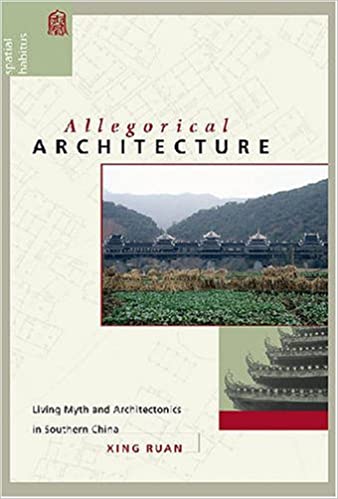
Allegorical Architecture: Living Myth and Architectonics in Southern China
University of Hawaii Press, 2007. Item #45857
ISBN: 9780824821517
"This may seem a specialized study of a minority group in Southeast China--whose partially transcribed language he learnt while studying their buildings--yet Xing Ruan has used this marvelous miniature to illuminate the complex relation between many other societies, their daily life, their rituals and ceremonies, and their buildings. But the book is much more. Xing Ruan extrapolates from his miniature a timely and very important reminder of how building and behavior interweave and how essential some understanding of that complex and vital relation must be for the future of the built environment." --Joseph Rykwert, Paul Philippe Cret Professor of Architecture Emeritus, University of Pennsylvania
"Allegorical Architecture is a truly remarkable achievement in that it is both a detailed ethno-architectural study of a small minority group, the Dong, in China, and also a work of far broader scope, one that boldly and subtly addresses major issues in built form and life, such as the importance of architecture as conveyor of meaning in the absence of written texts, the impact of majority culture on minority culture, and vice versa, change within tradition, tradition as change, and the implication of these findings and concepts for modern architecture and the modern world." --Yi-Fu Tuan, Professor Emeritus of Geography, University of Wisconsin
Allegorical Architecture offers the first detailed architectural analysis of built forms and building types of the minority groups in southern China and of the Dong nationality in particular. It argues that Dong architecture symbolically resembles its inhabitants in many ways. The built world is an extension of their body and mind; their experience of architecture is figurative and their understanding of it allegorical. Unlike the symbolism of historical architecture, which must be decoded through a speculative reconstruction of the past, the Dong tell stories about inhabitants in their living state in the recurrent process of ritualistic making and inhabiting of their built world. This book thus offers architectural analysis of both spatial dispositions (building types) and social life (the workings of buildings).
Xing Ruan likens the built world to allegory to develop an alternative to textual understanding. The allegorical analogy enables him to decipher minority architecture less as a didactic "text" and more as a "shell," the inhabitation of which enables the Dong to renew and reinvent continually the myths and stories that provide them with an assurance of home and authenticity. Attention is focused less on the supposed meanings (symbolic, practical) of the architecture and more on how it is used, inhabited, and hence understood by people. Throughout, Ruan artfully avoids the temptation to textualize the built world and read from it all sorts of significance and symbolism that may or may not be shared by the inhabitants themselves. By likening architecture to allegory, he also subtlety avoids the well-worn path of accounting for rich traditions via a "salvage ethnography"; on the contrary, he argues that cultural reinvention is an ongoing process and architecture is one of the fundamental ingredients to understanding that process.
Ruan offers "thick description" of Dong architecture in an attempt to understand the workings of architecture in the social world. Paying attention to Dong architecture within a regional as well as a global context makes it possible to combine detailed formal analysis of settlement patterns and building types and their spatial dispositions with their effects in a social context. Architecture, in a broad sense, is assumed to be an art form in which the feelings and lives of its makers and inhabitants are embodied. The artifice of architecture--its physical laws--is therefore analyzed and contested in terms of its instrumental capacity.
Allegorical Architecture is a work of refreshing originality and compelling significance. It will provide timely lessons for those concerned with the meaning and social sustainability of the built world and will appeal to architects, planners, cultural geographers, anthropologists, historians, and students of these disciplines.
Price: $50.00 save 60% $20.00
